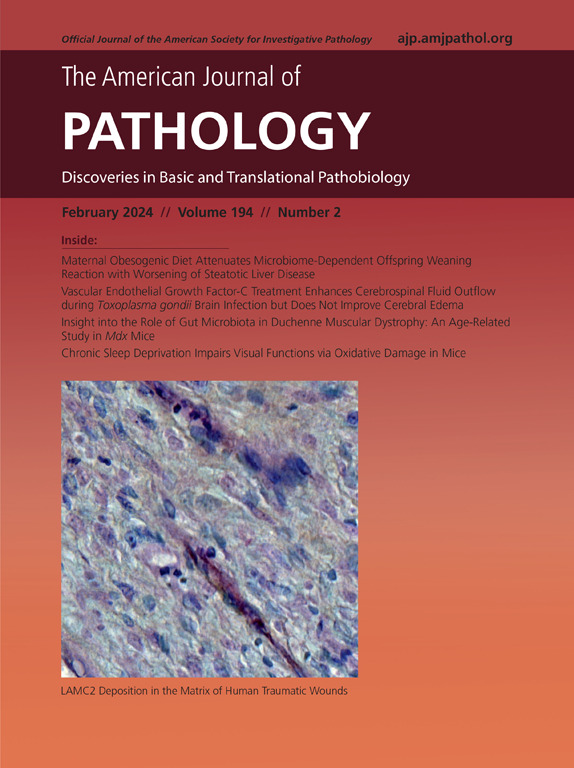Identification of a Growth-Promoting Gene Cluster in the Region 2q24 as a Driver of Tumorigenesis in Childhood Hepatoblastoma
IF 3.6
2区 医学
Q1 PATHOLOGY
引用次数: 0
Abstract
Hepatoblastoma (HB) represents the most common primary malignancy of the liver in childhood. Cytogenetic studies uncovered characteristic copy number alterations in HB. The frequent gain of chromosome 2q and particularly the recurrent 2q24 amplification suggest the presence of a so far unidentified oncogenic driver within this amplicon. Herein, high-resolution copy number profiles from 76 patients with HB were generated by using molecular inversion probe array technology. 2q gain was present in 63.2%, and 2q24 high-gain/amplification was present in 14.5% of patients analyzed. In the smallest overlapping region at 2q24.2q24.3, spanning >5.2 Mbp, 22 protein-coding genes, 2 long noncoding RNA genes, and one miRNA gene were mapped. RNA expression analysis of these smallest overlapping region genes identified RBMS1, BAZ2B, MARCH7, DPP4, FIGN, and TANK as overexpressed in 2q24 high-gain/amplified HB cases. Accordingly, these six genes were selected for further investigation. In situ, immunohistochemical staining showed higher protein expression of these genes in 2q24 high-gain HB tissue sections. In vitro, functional analyses were performed in established human HB cell lines carrying a 2q (high-)gain. Knockdown of these genes by specific siRNAs resulted in reduced proliferation and marked reduction of Wnt pathway activity. These genes located within the 2q24 amplicon might collaborate in driving cellular growth by interaction with the Wnt pathway that is known to be activated pathologically in HB.

2q24区域生长促进基因簇在儿童肝母细胞瘤发生中的作用
肝母细胞瘤(HB)是儿童肝脏最常见的原发性恶性肿瘤。细胞遗传学研究揭示了HB的特征性拷贝数改变。染色体2q的频繁增加,特别是2q24的反复扩增表明,在该扩增子中存在迄今尚未确定的致癌驱动因子。利用分子倒置探针阵列技术生成76例HB患者的高分辨率拷贝数谱。63.2%的患者存在2q增益,14.5%的患者存在2q24高增益/放大。在最小重叠区域2q24.2q24.3,跨越>5.2 Mbp,共定位到22个蛋白编码基因、2个长链非编码RNA基因和1个miRNA基因。对这些最小重叠区域基因的RNA表达分析发现,RBMS1、BAZ2B、MARCH7、DPP4、FIGN和TANK在2q24例高增益/扩增HB病例中过表达。因此,选择这6个基因进行进一步研究。原位免疫组化染色显示这些基因在2q24高增益HB组织切片中有较高的蛋白表达。在体外,对已建立的携带2q(高增益)的人HB细胞系进行了功能分析。通过特定sirna敲低这些基因导致增殖减少和Wnt通路活性显著降低。这些位于2q24扩增子内的基因可能通过与已知在HB中被病理激活的Wnt通路相互作用来协同驱动细胞生长。
本文章由计算机程序翻译,如有差异,请以英文原文为准。
求助全文
约1分钟内获得全文
求助全文
来源期刊
CiteScore
11.40
自引率
0.00%
发文量
178
审稿时长
30 days
期刊介绍:
The American Journal of Pathology, official journal of the American Society for Investigative Pathology, published by Elsevier, Inc., seeks high-quality original research reports, reviews, and commentaries related to the molecular and cellular basis of disease. The editors will consider basic, translational, and clinical investigations that directly address mechanisms of pathogenesis or provide a foundation for future mechanistic inquiries. Examples of such foundational investigations include data mining, identification of biomarkers, molecular pathology, and discovery research. Foundational studies that incorporate deep learning and artificial intelligence are also welcome. High priority is given to studies of human disease and relevant experimental models using molecular, cellular, and organismal approaches.

 求助内容:
求助内容: 应助结果提醒方式:
应助结果提醒方式:


